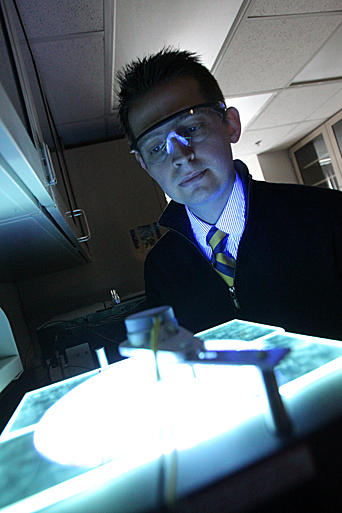
Dr. Jared Anderson observed the progression of a photochemical polymerization reaction being carried out in a UV reactor. The patented approach developed by Anderson and his research group allows for rapid and reproducible synthesis of polymeric ionic liquids on microextraction fibers.
At this year’s Pittcon, the world’s premier conference and exposition on laboratory science, he will be recognized as the 2012 recipient of the American Chemical Society’s Division of Analytical Chemistry Award for Young Investigators in Separation Science.
“He is a really bright young faculty member that is making quite a name for himself internationally in the field,” said Dr. Alan Pinkerton, professor and chair of the UT Department of Chemistry. “Dr. Anderson’s international recognition creates amazing visibility for the department. He is a real flag carrier.”
Anderson’s award comes just two years after being recognized by LCGC magazine, the largest chromatography publication in North America, as the 2010 Emerging Leader in Chromatography.
The most recent American Chemical Society award recognizes and encourages outstanding contributions to the field of separation science by a chemist or chemical engineer who has earned his or her highest degree within 10 years of the year of the award.
“It is nice to receive this type of award,” said Anderson, who joined the UT Department of Chemistry in 2005 as an assistant professor and was promoted to professor in 2011. “You really realize that the scientific community values your research contributions.”
Anderson also will have an entire session dedicated to his work Saturday, March 24, at Pittcon in Orlando, Fla.
His research revolves around the formation and use of ionic liquids, which have many uses, including one of his main focuses: separation science.
“Our ultimate goal is to develop extraction techniques using ionic liquids to identify and analyze compounds at low concentration levels,” Anderson said. “This would be impossible using conventional methods.”
His work is moving quickly into the pharmaceutical industry. Anderson is developing methods to remove small concentrations of chemical impurities that are used during the creation of pharmaceutical drugs.
“As instrumentation evolves to become more and more sensitive to detecting small levels of impurities, government regulations have significantly lowered the amount of these impurities that can be present in pharmaceutical drugs,” he explained. “Therefore, we are stepping up to the plate with our ionic liquid-based extraction methods in an attempt to quickly and selectively remove these impurities to permissible levels.”
Other applications of Anderson’s work include ways to remove impurities from polluted streams and the ability to assist in oil spill cleanup.
Anderson has been issued two patents for his work and hopes that his patented extraction fibers will be commercially available within the next couple of years.